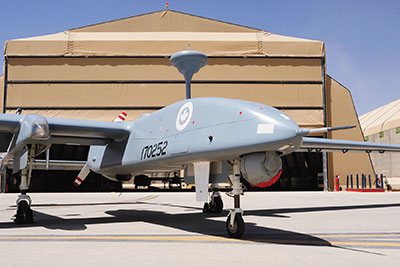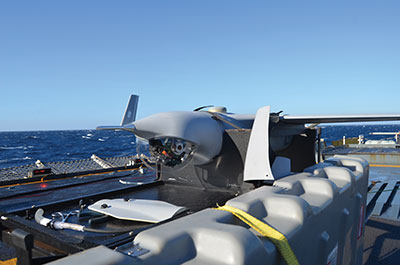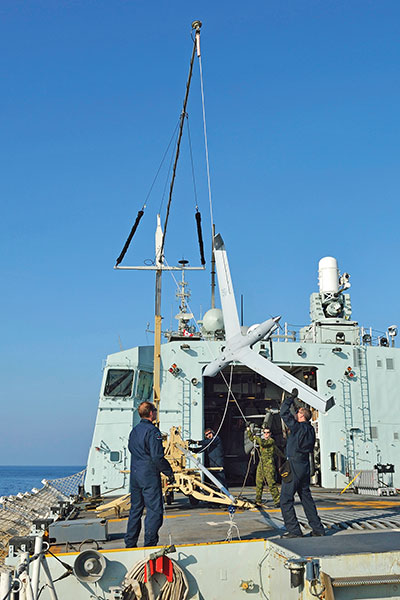
Features
Drones
Sharing the skies
Coming soon to a sky near you: drones! There is no shortage of hyperbole, distortion and misunderstanding in public perception of the current and future state of unmanned aerial vehicles (UAVs) in Canada.
March 4, 2014 By Paul Dixon
Coming soon to a sky near you: drones! There is no shortage of hyperbole, distortion and misunderstanding in public perception of the current and future state of unmanned aerial vehicles (UAVs) in Canada. The public has become aware of “drones” after more than a decade of nightly news reports on the use of the use of drones in a variety of military roles in conflicts around the globe.
 |
|
| The CU-170 Heron UAV is a one ton aircraft that can conduct operations in excess of 24 hours with a maximum speed of more than 100 knots (180 km/h) and at altitudes of up to 10,000 metres. PHOTO: Sergeant Daren Kraus, Image Tech, TFK Afghanistan, Roto 9
|
The announcement by Amazon CEO Jeff Bezos in December 2013 that Amazon was developing its own airborne delivery service, Amazon Prime Air, with the intention of delivering an order to the customer in 30 minutes or less. Apart from the fact that current regulations would currently prohibit such a service, there is also the little matter of whether such an endeavour would ever be technically feasible. Reality aside, it certainly did get Bezos some serious media exposure for free and did spark public interest.
The term “drone” has won common acceptance to describe a wide variety of systems and technologies that more accurately can be referred to as Unmanned (or Uninhabited) Aerial Vehicles (UAVs), Remotely Piloted Vehicles (RPVs), Remotely Operated Aircraft (ROA) and Unmanned Combat Aerial Vehicles (UCAVs) to more accurately describe the aircraft and its intended uses. Section 101.01 of the Canadian Aviation Regulations (CARs) states, “Unmanned Air Vehicle” means a power driven aircraft, other than a model aircraft, that is operated without a flight crew member on board. Whatever they are called, they are all considered to be aircraft from a regulatory point of view and for the purposes of this article we shall use the terms UAV and drone interchangeably.
UAVs are generally classified into three main groups based on a number of criteria including the basic characteristics of the aircraft, its mass and speed, means of power and number of engines, the type of aircraft (fixed-wing, rotary-wing, airship), endurance and range, its designed to operator within visual range or beyond visual range, the mission and payload, the level of supervision and/or automation, failure mode or flight termination system, and the method of launch and recovery.
High Altitude Long Endurance (HALE) vehicles operate above 50,000 feet with endurance of long as 36 hours or longer. The Northrop Grumman Global Hawk jet-powered UAV is a prime example of this type, with the wingspan of 40 metres. Medium Altitude Long Endurance (MALE) UAVs operate up to about 25,000 feet and have endurance of 24 hours. They can provide continuous surveillance at tactical ranges and have the flexibility to be armed for strikes.
The Predator is the prime example of these. For shorter-range requirements there is a very wide range of UAVs stretching right down to hand-launched vehicles such as Desert Hawk; typically these vehicles allow a ground commander to see over the next hill and to patrol his close-in area of interest. Large fixed-wing UAVs require runways and hangar facilities, as well as sophisticated ground-control stations and highly skilled operators. Smaller fixed-wing UAVs can be launched by catapult or even by hand. At the other end of the spectrum, Transport Canada (TC) refers to anything less than 35 kilograms as a “model aircraft” in the sense that aircraft of this size have been generally flown by members of organized clubs in specific sites or by universities or research institutions.
The Canadian military has had considerable experience in Afghanistan with UAVs and in the words of Royal Canadian Air Force Lt.-Gen. Yvan Blondin, the experience was overwhelmingly positive. He was personally impressed with the incredible amount of information these systems can provide in a military context. Appearing before the Senate Defence Committee in March 2013, Lt.-Gen. Blondin spoke of his desire to acquire a platform that is able to fly on extended, long-range surveillance patrols far out to sea off Canada’s Atlantic and Pacific coasts, as well as conduct Arctic sovereignty patrols.
 |
|
| The ScanEagle unmanned aerial vehicle (UAV) is prepared for takeoff from HMCS Charlottetown during a surface exercise for Operation Active Endeavour on Feb. 29, 2012. PHOTO: OS Jason McIssac, HMCS Charlottetown
|
Lt.-Gen. Blondin also noted that these machines could be deployed in humanitarian missions such as the response to Haiti in 2010, where the ability to more quickly determine the damage to roads and other infrastructure in remote areas would have been invaluable. Blondin’s comments were backed by the Chief of Defense staff, Gen. Tom Lawson, in a November, 2103 speech to the Center for Strategic and International Studies. Lawson said the purchase of a fleet of drones was included in the 2008 Canada First Defence Strategy. The decision to be made is whether Canadian drones will be armed or strictly for intelligence, surveillance and reconnaissance (ISR) purposes. Reportedly, the government is considering purchasing up to 18 UAVs for the Royal Canadian Air Force: Medium Altitude Long Endurance (MALE) aircraft such as the Heron, which the Canadian Forces has operated in Afghanistan, or High Altitude Long Endurance (HALE) machines such as the Predator or possibly a combination of types. No specific costs have been released but the project’s price tag is estimated to be more than $1.5 billion.
The RCAF had considerable experience with UAVs in Afghanistan, from small hand-launched units used to support infantry operations, to the larger Boeing ScanEagle and up to MALE UAVs, starting with the CU-161 Sperwer in 2003 and followed by the Israeli-developed Heron. Small UAVs that could be carried in a backpack, assembled, deployed and operated by a single soldier gave front-line infantry units the ability to conduct tactical assessments of their immediate environment, whether taking a closer look at potential roadside IEDs or simply being able to look and see what may or may not be hiding behind a wall or building 100 metres away. The Herons, leased from Israel, had an operational ceiling of up to 27,000 feet with a flight endurance of up to 45 hours depending on mission profile and the sensor package.
In 2011, Canadian frigates operating in the Mediterranean in support operations in Libya and on piracy patrols in the Gulf of Aden and off the coast of Somalia used UAVs. Originally developed as a tool by the American firm Insitu, now a subsidiary of Boeing, to conduct offshore surveys to assist commercial fishermen by collecting weather information and tracking offshore fish, the ScanEagle today carries either an optical camera or an IR camera in an inertia stabilized system and has endurance of up to 20 hours. The UAV is launched by compressed air and is retrieved using a “skyhook.” In 2009, a ScanEagle was used by the U.S. navy for surveillance purposes during the Maersk Alabama high jacking incident.
The current state of UAVs is akin to aviation at the end of the First World War. In the past decade, the military have come to rely on UAVs to fill a number of roles and are seeking to expand both the technology and the roles. On the civil side, many operators see the commercial potential for UAV operations in a number of areas, but current regulations restrict a wholesale unleashing of machines in a repeat of the barnstorming era of the 1920s. If the Canadian military is to enter the world of UAVs to the extent suggested, there are lessons that can be learned by those in the civilian world who have designs on commercial UAV operations. There are a number of issues that will have to be addressed before UAVs can enter commercial service in any meaningful numbers, and these include certification process, registration, maintenance regimes and especially, pilot/operator training and certification.
It may come as a surprise to many Canadians to know that TC has been working closely with industry over the same period to develop regulations for the operations of UAVs in Canadian airspace. Under current TC regulations, UAVs operating in Canada must meet “equivalent” levels of safety as manned aircraft and no one may operate an “unmanned aerial vehicle” without a Special Flight Operation Certificate (SFOC). The terms of reference for the working group state that “the primary goal of the working group is to define a performance-based regulatory framework for medium- to long-range, medium altitude, beyond line-of-sight UAV operations in Canadian airspace.” That said, the group realized very early in the process that most future UAV operations would likely be small UAVs operated at low altitudes, rather than larger, general aviation-sized aircraft that are capable of flying in Class A or Class B airspace.
The Working Group includes representation from TC, DND, NAV CANADA, National Research Council, Canadian Owners and Pilots Association and 16 private-sector Canadian UAV stakeholders including unmanned aerial system (UAS) system developers, operators, UAV sector associations and academia.
 |
|
| Brad McPhee (left) and Denis Dagenais (right) recover the ship’s unmanned aerial vehicle (UAV) (ScanEagle) after being caught by the Skyhook during operation Artemis in the Arabian Sea on Nov. 8, 2012. PHOTO: Crpl Rick Ayer, Formation Imaging Services, Halifax, Nova Scotia
|
However, working group members realized early on that the basis of future UAV operations would not be general aviation sized aircraft, but rather small lightweight UAVs operated at low to medium altitudes and beyond visual range. At present, there are a very limited number of UAV models that are capable of flying in Class A and/or B airspace, and they are very expensive. In the U.S., for example, UAVs that fly at low altitude and weigh less than 10 kilograms are expected to make up approximately 80 per cent of civil production. Medium- and high-altitude aircraft may make up only five to six per cent of all civil unmanned aircraft production.
The working group recommendations capture “medium to long-range, medium altitude, beyond line-of-sight operations,” but the bulk of recommendations are more comprehensive in nature to address the emerging market. A summary of the scope is found at Section 5.0.
Stewart Baillie, chairman of Unmanned Systems Canada, sees this as an exceptionally positive arrangement. “The regulator and the industry are collaborating and working together,” says Baillie. “Everyone has a lot of time for us and certainly we are having good discussions.” Bailllie described TC as being very pragmatic given that they are working with limitations of budget and staff.
“They’ve been very receptive, we’re helping to develop the syllabus, we’re talking about registering aircraft and they are quite open to us (the industry) doing some of the legwork and then trying to adopt (suggestions) as best they can,” he notes. An example of the willingness of the regulator to work with the industry was the full-day workshop at the 2013 Unmanned Systems Canada Conference in Vancouver last November that featured Martin Eley, director general of civil aviation and other officials from TC.
The problem will come as more UAV operators come on line and SFOC requests increase accordingly. SFOCs are issued by the TC regional offices, by general aviation inspectors who have a wide range of responsibilities. Within TC there is not a single position that is specifically responsible for UAVs and this situation will create a bottleneck as SFOC requests increase. The good work done by working with industry may come to naught if certificate requests cannot be handled in a reasonable timeline. As much as the regulations are required to enable the industry to grow, TC needs to be given enough staff with the requisite skills to support the industry as it moves out of the incubator and into its growth phase.
Future growth in the Canadian UAV industry can only come from within. Canadian universities and colleges are seeing a surge in interest around UAVs. The Unmanned Systems Canada Student Competition started a decade ago with three entrant teams. This year’s competition will see 16 teams from institutions across Canada converge on Southport in Manitoba. The three-day competition will see teams integrate an aircraft, sensor package and ground control station as they are given a complex series of tasks to perform based entirely on real-world situations.
The potential exists for UAVs to operate in many environments in a wide variety of roles, in some cases potentially replacing piloted aircraft while in other situations working in concert with piloted aircraft to increase the efficiency and effectiveness of the mission. The day is coming when UAVs will operate in civil airspace, but until the technology is developed that will enable UAVs to be fully integrated and the regulatory framework is in place, it will be one step at a time.